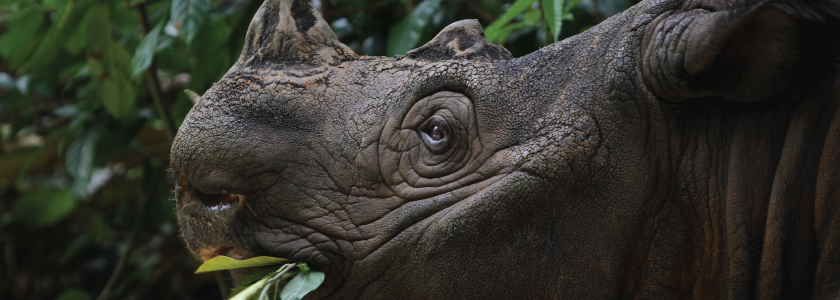Help is on the way for the endangered Sumatran rhino, courtesy of NGS sequencing

The Takeaway: With less than 80 individuals left, the endangered Sumatran rhino is likely one of the rarest mammals in the world.
The 3.5-foot tall, 1,700-pound, two-horned Sumatran rhino once roamed from the foothills of the Himalaya in Bhutan through India, Myanmar, Thailand, and south across the Malay Peninsula. It may have lived as far east and north as China and Vietnam.
Today, there are only two very small, very nervous populations of Sumatran rhinos, one on the Indonesian island of Sumatra, and one on the next big island over, on the Indonesian side of Borneo. Discouragingly, only two captive females have reproduced in the last 15 years, and the remaining animals must contend with habitat loss, fragmentation, and poor chances of finding a mating partner. Their future seems doomed.
Sequencing shows hope for Sumatran rhinos amid dire predictions
With researchers focused on learning as much as possible about the Sumatrans rhino as fast as they can, a team from the Centre for Palaeogenetics in Sweden recently sequenced the genomes from 21 modern and recently extinct rhino populations and made some surprising discoveries.
The study, which was published in Nature Communications, investigated the genomes of 16 survivors on Sumatra, including 5 from a recently extinct population on the Malaysian Peninsula, in an effort to estimate inbreeding levels, genetic variation, and the frequency of potentially harmful mutations.
Next generation sequencing (NGS) solutions, such as those offered by IDT, are an integral part of genetic research and discovery. The ability to generate large amounts of sequence data in a relatively short amount of time is helping to enable a wide range of genetic analysis applications and accelerate advances in research, clinical, and applied markets.
“To our surprise, we found relatively low inbreeding levels and high genetic diversity in the present-day populations on Borneo and Sumatra,” said Johanna von Seth, a PhD student at the Centre for Palaeogenetics and co-lead author on the paper.
With such a small population, inbreeding seems likely, hinting that the population decline is recent and that inbreeding has not caught up with the small population size. It also means that there is still time to preserve their species’ genetic diversity.
Genetic diversity also haunts remaining populations of bison, condors, and more
A lack of genetic diversity, due in large part to small populations and inbreeding, is a common thread found in many populations of threatened species, particularly in North America, where genetic research into wildlife population has been relatively rich.
Genetic diversity is a big deal for wildlife as it helps the animals confront change and adversity, but even the advances found in genetic science today can’t replicate the genetic diversity that is now missing; it can take thousands of years for natural mutations to build up the diversity needed to sustain wild animal populations -- especially those in peril -- such as Canis lupus bailey, the Mexican gray wolf.
For example, studies have shown that although their population numbers are healthy, today’s American bison descend from just a relative handful of animals that survived a massive nationwide sport hunting spree.
“Bison squeezed through a perilously small genetic bottleneck in the late 1800s with the hunting and extermination of the massive animals that had numbered in the tens of millions,” the Associated Press wrote. “At one point, fewer than 1,000 survived.”
Southern California’s mountain lions likewise suffer from small populations bisected by freeways and suburbs, and there is little genetic variability in the surviving populations, meaning they are more susceptible to disease. Even without this modern day isolation, the small size of the species alone would endanger it. The National Park Service estimates that just a few untimely mountain lion deaths—say, from car accidents, or the accidental ingestion of rodenticide—could “disrupt breeding and lead the population into a downward spiral.”
Same goes for California condors, which are benefitting from improved habitat but whose small remaining populations are hamstrung by a lack fo genetic diversity.
Meanwhile, the grizzly bears in the Lower 48 have similarly dismal genetic variability, though it has increased in recent years as populations have rebounded. One study of genetic diversity in Montana showed rapid increases between 2004 and 2012; researchers used the information to create a family tree for the bears and found that young bears in the Glacier National Park region of Montana were slowly migrating south.
An earlier study estimated that as few as 2 bears per generation migrating between populations around Glacier National Park and around Yellowstone National Park (these two grizzly hotspots are about 400 miles apart) would be enough to maintain genetic continuity.
And further to the south, because there are less than 200 Mexican wolves left in the wild, aggressive efforts called “cross fostering” are placing captive born pups into wild dens in an attempt to bring outside genetic characteristics to extant wild populations.
How can we save the Sumatran rhino? Land conservation, and a genetic boost!
Research on recently extinct rhino populations on mainland Malaysia show what might happen to the remaining herds on Sumatra and Borneo. While better land protections are needed so the animals can remain in prime habitat, it is genetic variability that will be key to future survival. Exactly how that happens is yet to be seen.
“The Sumatran rhino is by no means out of the woods,” said Love Dalén, a professor of evolutionary genetics at the Centre for Palaeogenetics. “But at least our findings provide a path forward, where we might still be able to rescue a large part of the species' genetic diversity.”


 Processing
Processing
